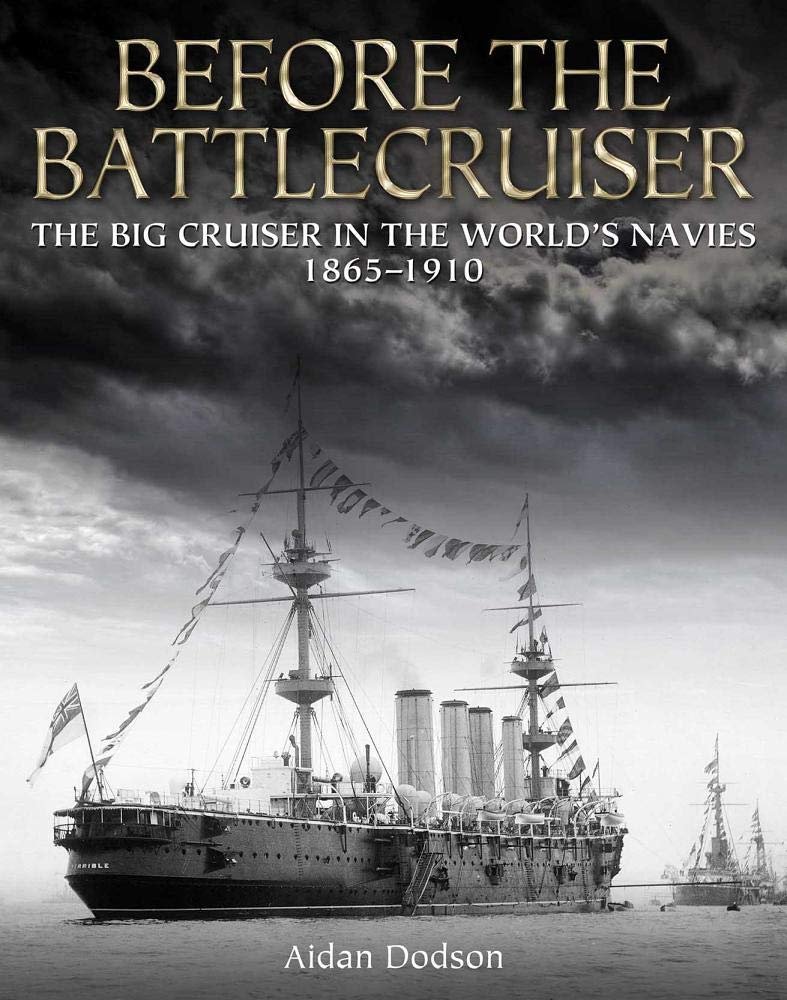Before the Battlecruiser: The Big Cruiser in the World’s Navies, 1865-1910
Aidan Dodson
 The historiography of warship technology in the second half of the nineteenth century is dominated by analysis and discussion of developments in battleship design, essentially, the competition between protection and artillery that culminated in the emergence, in the very early 1900s, of the dreadnought type. Battleships also became the defining metric for contemporary determination of relative naval power.
The historiography of warship technology in the second half of the nineteenth century is dominated by analysis and discussion of developments in battleship design, essentially, the competition between protection and artillery that culminated in the emergence, in the very early 1900s, of the dreadnought type. Battleships also became the defining metric for contemporary determination of relative naval power.
Aidan Dodson’s Before the Battlecruiser, however, illuminates the development of “big cruisers” during the same period. In general, these vessels, compared with their battleship contemporaries, were faster, not quite as heavily armed, and less well protected. They were constructed to serve as major warships in more distant waters, as commerce raiders, or as fast scouts for the battlefleet. Just as battleship development culminated in the dreadnought type, so these large cruisers evolved into the battlecruisers of the early 1900s. But this story has received very little previous attention. Much more has been written about torpedo boats and destroyers or submarines than on these large cruisers.
This lack of attention is quite remarkable because the technological developments embodied in these cruisers made them major factors in and drivers of contemporary naval doctrines. Their development and use as powerful, long-ranged raiders underpinned a major thread of naval strategy built around campaigns against commerce rather than decisive encounters between battlefleets. Their construction and deployment as capital ships outside European waters enabled and then consolidated much of Europe’s colonial expansion in the later nineteenth century. Their ultimate emergence and deployment as heavily armed fast elements for battlefleets drove efforts to develop true fast battleships.
The most remarkable detail that emerges from Before the Battlecruiser is sheer scope of the big cruisers’ operational contributions during this period. Big cruisers, either in their own right or as major components of battlefleets, engaged in almost every significant naval combat, and a host of lesser skirmishes, during the later nineteenth century. Cumulatively, these ships saw appreciably more action than their battleship contemporaries.
Dodson’s exposition of this story is presented in two sections. A very thorough analysis and description of the origins, development, and operational employment of these bog cruisers fills the first half of the book. This text is supported by a quite excellent selection of photographs, all clearly printed and many rarely published before. The second half is a catalog of the more than two hundred ships of this type that entered naval service. The catalog presents the usual vital statistics one expects, supported by small sketch broadside representations to scale of the ships. A considerable number of these sketches either come from contemporary editions of Brassey’s Naval Annual or Jane’s Fighting Ships or are rendered in the same style.
Before the Battlecruiser is a major contribution to the literature of naval development in the later nineteenth century. It is a beautifully presented, thoroughly analyzed, and lucidly written presentation of a long-neglected topic. It needs to find a place in the library of any serious student of warship history of the period.
- Barnsley: Seaforth Publishing, 2018
- Annapolis: Naval Institute Press, 2018
- 9” x 11-1/4”, hardcover, 304 pages
- Photographs, diagrams, maps, appendices, notes, bibliography, index. $57.95
- ISBN: 9781473892163
Reviewed by Christopher Conlan, Philadelphia, Pennsylvania
